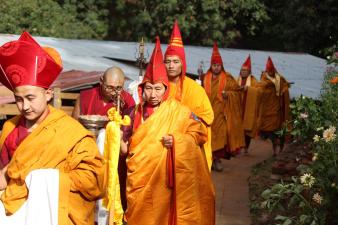EE00002324
 Yarney: the Summer Retreat
Yarney: the Summer Retreat
Yarney is one of the mainstays of monastic life in Buddhist communities, the tradition descends from the time of Buddha until today. It is observed as one of the most important annual events in Buddhist monasteries and institutions. ‘Yar’ means ‘summer’ and ‘ney’ means ‘to stay or abide’. Varsavasa is the Sanskrit term for Yarney, and like the Chokey term it is rather literal: varsa means ‘rains or rainy season’ and vasa means ‘dwelling or residence.’ The term widely used in Bhutan is Yarney.
The origin of Yarney practice can be traced back to the historical Buddha, Siddhartha Gautama, 2600 years ago in India. The first Buddhist monks did not build monasteries and temples; they were mostly homeless and depended solely on alms for their sustenance. However, the summer’s monsoon rains presented a number of obstacles to Lord Buddha and his Sangha Buddhist community to make daily customary alms round from village to village and teaching tours.
Not only is it unhealthy and uncomfortable to be unhoused in the rains, but the nurturing rains bring forth insects and worms who inhabit the muddy walkways and small plants and newly planted rice paddies would start budding in the fields. At that time the Tirthikas non-Buddhist critiques of Buddha Gautama would criticize the practice of alms round, reasoning that walking for alms especially during the summer killed several animals and insects.
So to keep from crushing insects or young crops in their tender state; and avoid the health hazards of the monsoon rains, flooding, and displaced wildlife, the Buddha established the rainy seasons as a time for retreat. This is codified in the Vinaya rules for the monastic community. Instead, they would remain within the premises of their residences or dwelling places, most often monasteries, each summer or venture to a specific rainy season retreat. For the monasteries, the place Sangha members observe Yarney must be conducive to spiritual and mental development. One of the main objects of observing Yarney is to set aside time to practice meditation outside the schedule of preaching the Dharma to lay devotees or going on alms rounds. The period for the retreat lasts three months by the lunar calendar, usually starting in June or July and would continue until September or October. This established a formal practice of observing Yarney – Buddhist monastics using the summer or the rainy season as an opportunity to take retreat.
The Buddha and Sangha would stay and spend days in their residences. This was a period for the Sangha to spend time in quiet and serious meditation, give local Dharma talks and help laypeople and junior Sangha members in spiritual development. It was also opportune time for them to clarify their understanding of every aspect of the Buddha’s teachings through questions and discussions. As the tradition progressed, it became renowned as a productive period in which the sutras were said to have been written down.
Thus, during Yarney monastics engage their vows; listen and contemplate lob pa thoe sam; and meditate on teachings pong wa sam tan they received from their Khenpo or abbot. During Buddha’s time, many monks and practitioners were said to have achieved the accomplished state of Arhat, non-returner, and once-returner through this deep study.
Bhutan



